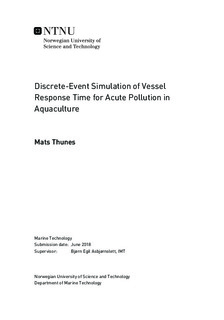| dc.description.abstract | The aim of this master's thesis is to identify vessel response time for acute pollution in aquaculture. As this is a acute emergency, an imminent response is needed from the vessels to transport the fish away from contaminated area and deliver the biomass to emergency slaughter. A discrete-event simulation is developed in Simulink, a program extension found in MATLAB. A model was built to replicate normal operations for live fish carriers, and to give a more realistic starting point for emergency response. The output from normal operations and response times, were the basis in setting a benchmark fleet for operations and emergency response. Normal operations were limited to loading and unloading of fish, and all other vessel operations were excluded from the system.
The motivation for conducting this study, was the Norwegian governments goal to increase aquaculture production, and the increased shipping activity in near-cost areas. An increase in both industries, could potentially lead to new challenges. Damage to Norwegian aquaculture has so far been avoided from oil spills, but this could change. If a fish farming location should be threatened by an oil spill, a well developed emergency response system could be beneficial for rapid transportation of the biomass away from the contaminated area.
The simulation model was run with several fleet compositions in an attempt to establish a fleet for normal operations and emergency response in the area of interest. The different fleet compositions were evaluated from performance in normal operations and how fast it was able to respond to an emergency. Case study 1 used a fleet of three operational live fish carriers. Case study 2 used two operational vessels, and case study 3 used one operational vessel. However, the two last fleet compositions were assisted by a dedicated standby vessel when emergency slaughter was needed.
The results showed that the fleet composition from case study 3 were able to perform well in operations, and achieved low response time when emergency slaughter was imposed. The other fleet compositions experienced accumulation of waiting vessels outside farms and processing facility. The fleet from case study 1 and 2, would cause to much strain on the slaughter facility when delivering huge amounts of fish at short intervals during normal operation.
In conclusion, further research and increased focus on acute pollution and emergency response in aquaculture was found necessary. On-shore infrastructure could need expansion to have the ability to process the amount of fish in emergency slaughter situations. Further work should include added complexity in the logistical model, and more accurate input data. | |

